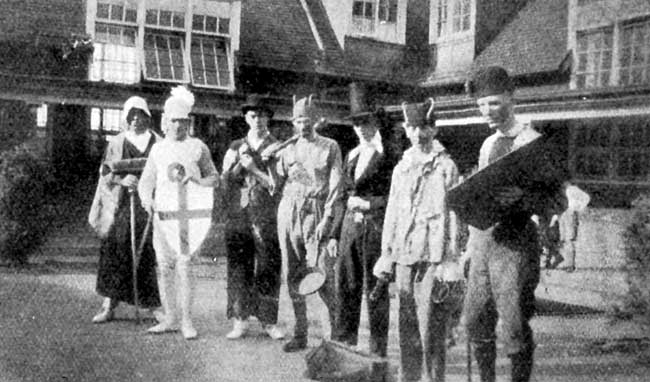< Previous
Folk Lore of Nottinghamshire
By Frances Collingwood
IF you want to get at the very essence of a county, seek out its traditional customs. Nottinghamshire is rich in folk-lore which takes one back without a break to Mediaeval England and far beyond that. In some parts of the county the links are unbroken, but many of the old customs have fallen into disuse or lost their meaning with the passing of time.

The Characters of a Plough Monday Play.
Perhaps the most interesting of all are the Plough Monday Plays, versions of which have been found in Clay worth and Blidworth. The dialogue of these plays is but a trivial nonsense, yet behind it the meaning is charged with a powerful reality.
The characters in the Clayworth play are a Soldier, Old Eezum Squeezum, Clown and Doctor. These people are entirely symbolic and may bear different names in another village. Sometimes King George or Saint George appears instead of the Soldier. Often Old Eezum Squeezum has his place taken by Beelzebub. But they stand for the same thing, Good and Evil, Light and Darkness, Life and Death.
The action of the play always leads up to a struggle between these two, which ends in the apparent death of the Evil one, who is eventually restored to life by the Doctor.
The Blidworth version is extant to this day, although the form in which it survives has lost much of its ritualistic flavour. Here a story is enacted in which King George and his companions are a Pressgang looking for likely victims. A man is knocked down for dead and the Doctor doses him from a large bottle— whereupon the man is cured and the play acting comes to an end with the singing of a song about beer! "We thank you for your kindness and a pint o' yerr bes' be-ur."
The players go from door to door and for the sum of sixpence will perform in the kitchen. The custom is known in Blidworth as Plough-Bullocking and in former days the sacrifice of a bullock for the purposes of propitiation would have been part of the ceremony.
The Plough Monday Plays originally contained a Sword Dance, but this gradually dropped out. In some parts of the country, notably in Yorkshire, the dance alone survives, while some of the characters from the play remain as accompanying figures. Ampleforth and Revesby seem to be the only places left in England where the dance and play have been preserved as a single unity.
Plough Monday is the first Monday after Twelfth Day, which brings this ceremony into the second week in January, a time when everything is apparently dead. Primitive man found it hard to believe that the earth would wake up again to bear him its fruits. Even though he saw the miracle happen each year, he was afraid. And so he exercised the rite of Imitative Magic. A mock battle between Light and Darkness was enacted in which Darkness was apparently slain and then brought to life again by an outside healing force. In this way man symbolized the death of the Old Year and rebirth of the New arising out of the ashes of the old. By Imitative Magic he hoped to make sure that the powers of Life would triumph over Death. And so you have in the Plough Monday Plays, the fight and the Doctor who restores life.
It is the custom for those who take part in these plays to blacken their faces and to wear something of animal or flower life about them. The blackening of the face is very often only a smear, but the idea was partly to become impersonal and partly as disguise for fear of being suspected of the killing.
"I am sure it's none of I
That did this awful crime
It's he that follows me
That drew his sword so fine."(Ampleforth Sword Play)
The wearing of flowers, fur or feathers was a way of propitiating Nature by becoming identified with her.
Another interesting ritual connected with this time of the year was a kind of Ball Game. This consisted of a gigantic struggle between groups of people trying to push or kick a ball over the village boundary. Sometimes one village would be pitted against another. Again the contest between Good and Evil is symbolized. Or, in some cases, the ball was identified in men's minds with Evil Spirits which it was necessary to expel from the village community. The Eakring Ball Game seems to have been held on Easter Tuesday, but doubtless this was in comparatively recent times when the game no longer held its true meaning for the villagers. The weather on Easter Tuesday was likely to be more pleasant than that of early January.
The May Day Festival was of quite a different nature. Instead of fear of the forces of Nature, here is thanksgiving and rejoicing at the coming of Spring.
Whole communities of people would join together in dancing round something which stood to them as a symbol of fertility. Sometimes this would be a tree, at other times a village cross or stone which represented the centre of communal life. In later years, when the festival had lost a great deal of its spontaneous impulse, the Maypole became the token of the life force.
A Maypole still stands on the village green at Wellow, formerly it was hung with fresh garlands of flowers each Spring Festival, but now the garland-carriers, which hang from its summit, are empty. It would be interesting to know if there is a record of its last authentic use.
Other Maypoles stood in Edwinstowe, Linby, Farnsfield and Stapleford. There was even one at the end of Parliament Street, Nottingham, till the year 1780.
The traditions of Folk Dancing in the county are carried on by local branches of the English Folk Dance Society, whose founder, the late Cecil Sharp, did so much for the folk art of England by rescuing from oblivion many dances and songs in the country before they died out.
Under the auspices of the Society, Folk Dancing is being practised in many parts of Nottinghamshire.
In the summer of 1931 the North Notts. Branch held a combined festival with Derbyshire and Leicestershire. On this occasion they were able to procure the lovely grounds of Donington Hall. Here several hundreds of dancers from the three counties made a pleasant picture against a background admirably suited to their movements.
Watching the evident enjoyment, it was interesting to reflect on the links with the past that have made it possible for the sophisticated human being of to-day to take pleasure in an art derived from the primitive religious instincts of his ancestors.
< Previous
